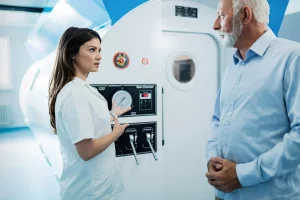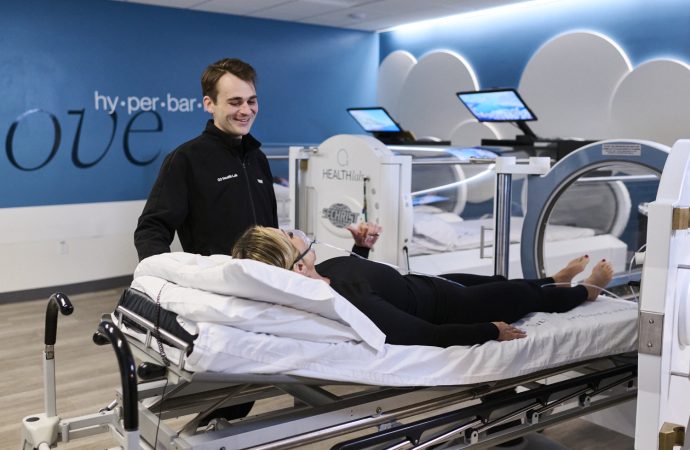Introduction Imagine healing your brain simply by breathing extra oxygen under gentle pressure. That’s the promise of hyperbaric oxygen therapy (HBOT). Once reserved for deep-sea divers with “the bends,” HBOT now shows real potential for improving brain health. By flooding tissues with pure oxygen, HBOT supports neuroplasticity, reduces inflammation, and boosts cognitive function. In this
Introduction
Imagine healing your brain simply by breathing extra oxygen under gentle pressure. That’s the promise of hyperbaric oxygen therapy (HBOT). Once reserved for deep-sea divers with “the bends,” HBOT now shows real potential for improving brain health. By flooding tissues with pure oxygen, HBOT supports neuroplasticity, reduces inflammation, and boosts cognitive function. In this article, we’ll explore exactly how HBOT works, the science behind its brain benefits, the conditions it may help, and what to expect during treatment. If you’re curious how oxygen under pressure can heal the mind, read on.
What Is Hyperbaric Oxygen Therapy (HBOT)?
HBOT involves breathing 100% oxygen inside a pressurized chamber. In a typical session, pressure rises to 1.5–2.5 times normal atmospheric levels. This extra pressure dissolves more oxygen into the blood plasma, allowing it to reach areas with limited blood flow. Treatments usually last 60–90 minutes and occur once or twice daily over several weeks, depending on the condition.
Key facts:
- 100% Oxygen: Unlike normal air (21% oxygen), HBOT delivers pure oxygen.
- Increased Pressure: Pressure levels in a chamber equal being 30–50 feet underwater.
- Enhanced Delivery: Plasma carries extra oxygen deep into tissues.
Originally approved for treating decompression sickness and carbon monoxide poisoning, HBOT’s range of uses now includes wound healing, radiation injury, and increasingly brain-related disorders.
How HBOT Supports Brain Health

Image by: Yandex.com
1. Boosting Oxygen Delivery to Brain Tissue
The brain consumes 20% of the body’s oxygen but cannot store it. Any drop in supply—due to stroke, injury, or age—hurts function. HBOT floods blood with oxygen, increasing the amount dissolved in plasma. This extra oxygen:
- Reaches areas with damaged or narrow blood vessels.
- Supplies energy-starved neurons, helping them survive and function.
- Clears metabolic waste products more efficiently.
By improving oxygen supply even to poorly perfused areas, HBOT lays the groundwork for tissue repair and recovery.
2. Reducing Inflammation
Inflammation in the brain contributes to many neurological issues, from traumatic brain injury (TBI) to Alzheimer’s disease. HBOT fights inflammation by:
- Inhibiting pro-inflammatory cytokines (signaling proteins).
- Reducing edema (swelling) around injured tissues.
- Modulating immune cell activity toward healing.
Studies in animal models show that HBOT decreases markers of inflammation in the brain, creating a more favorable environment for neurons to heal.
3. Promoting Neuroplasticity
Neuroplasticity is the brain’s ability to form new connections after injury or learning. HBOT enhances this by:
- Stimulating the release of growth factors like BDNF (brain-derived neurotrophic factor).
- Encouraging the formation of new blood vessels (angiogenesis).
- Supporting stem cell mobilization from bone marrow to damaged areas.
Research on stroke patients and TBI survivors shows improved learning, memory, and motor skills after HBOT, suggesting real-world changes in neural networks.
4. Enhancing Cognitive Function
By combining oxygen delivery, reduced inflammation, and boosted neuroplasticity, HBOT can improve:
- Memory recall and retention.
- Attention span and focus.
- Processing speed in decision-making tasks.
- Mood and emotional regulation.
Several small clinical trials report cognitive gains in older adults and brain-injured patients, though larger studies are still underway to confirm these effects.
Conditions Where HBOT May Help Brain Health
1. Traumatic Brain Injury (TBI)
TBI from falls, sports, or accidents can cause long-term cognitive and emotional issues. HBOT applied weeks or months after injury has been shown to:
- Reduce headache intensity and frequency.
- Improve sleep patterns and fatigue levels.
- Enhance attention and executive function.
2. Stroke Recovery
After a stroke, parts of the brain suffer from reduced blood flow. HBOT in the subacute and chronic phases can:
- Promote penumbral tissue salvage (areas surrounding the core infarct).
- Improve motor function and speech in some patients.
- Reduce disability scores months after the event.
3. Post-Concussion Syndrome
Athletes and accident survivors may experience lingering headaches, memory problems, and mood swings after a concussion. Studies suggest HBOT may:
- Shorten symptom duration.
- Reduce post-concussion fatigue.
- Enhance quality of life scales in follow-up assessments.
4. Age-Related Cognitive Decline
Mild cognitive impairment and early dementia stages involve reduced cerebral oxygen metabolism. Early research indicates that HBOT protocols could:
- Increase memory test scores in older adults.
- Improve cerebral blood flow on imaging studies.
- Slow the progression of daily living impairment.
Ongoing trials are investigating HBOT’s role in Alzheimer’s and vascular dementia.
What to Expect During HBOT Sessions
1. Pre-Treatment Evaluation
Before starting HBOT, you’ll undergo:
- Medical History Review: To rule out contraindications like untreated pneumothorax.
- Baseline Neurocognitive Tests: Memory, attention, and processing speed assessments.
- Imaging: MRI or CT scans to identify damaged brain areas.
2. The HBOT Chamber Experience
- Chamber Types: Single-patient “hard” titanium or multiplace soft chambers.
- Session Length: Typically 60–90 minutes per treatment.
- Comfort Measures: You can read, watch movies, or nap.
- Pressurization: You’ll feel mild ear popping—like in an airplane—adjustable by swallowing or yawning.
3. Post-Treatment Care
After sessions:
- Observation for Side Effects: Rare issues include middle-ear barotrauma or claustrophobia.
- Hydration Advice: Drink water to help clear waste metabolites.
- Homework Exercises: Neurocognitive tasks or physical therapy to maximize gains.
A full HBOT course often spans 20–40 sessions over several weeks.
Potential Risks and Contraindications
While generally safe, HBOT has some risks:
- Ear and Sinus Barotrauma: Pressure changes can hurt middle ear or sinus cavities.
- Oxygen Toxicity: High oxygen levels can, rarely, trigger seizures if protocols are not followed.
- Claustrophobia: Some patients feel anxious in confined chambers.
Contraindications include untreated lung collapse (pneumothorax) and certain chemotherapy drugs. A qualified HBOT physician will screen patients carefully and adjust protocols to minimize risks.
Scientific Evidence and Ongoing Research
1. Animal Studies and Early Trials
Rodent models of stroke and TBI consistently show reduced lesion sizes and better neurobehavioral performance after HBOT. These findings built the case for human studies.
2. Human Clinical Trials
- TBI Studies: Multiple small trials report cognitive and mood improvements lasting months post-HBOT.
- Stroke Research: Pilot studies indicate better motor recovery when HBOT is added to standard rehab.
- Aging Trials: Randomized trials in older adults show short-term gains in memory tests after 40 sessions .
3. Future Directions
Large, multicenter randomized controlled trials are underway to confirm HBOT’s benefits for:
- Alzheimer’s disease.
- Post-stroke rehabilitation.
- Chronic TBI symptom resolution.
Researchers are also exploring combined therapies—HBOT with stem cell treatments or neurorehabilitation exercises—for synergistic effects.
Tips for Choosing an HBOT Provider
- Medical Oversight: Ensure a board-certified physician directs the protocol.
- Accreditation: Look for centers certified by relevant hyperbaric medicine boards.
- Experience with Neurological Cases: Ask about past TBI or stroke patient outcomes.
- Chamber Quality: Verify maintenance records and patient safety measures.
- Comprehensive Care: Providers offering integrated rehabilitation services often yield better results.
A well-run center will track your progress with regular neurocognitive tests and imaging studies, adjusting the plan as you advance.
Conclusion
Hyperbaric oxygen therapy (HBOT) offers a promising path to brain health, from boosting oxygen delivery and reducing inflammation to driving neuroplasticity and enhancing cognitive function. Whether you’re recovering from a traumatic brain injury, rebuilding after a stroke, easing post-concussion symptoms, or seeking to slow age-related decline, HBOT can support healing at a cellular level. Though more large-scale studies are needed, current research and patient experiences point to real, lasting benefits. If you’re curious, discuss HBOT with your doctor and explore accredited centers. With the right team and protocol, breathing pure oxygen under pressure may launch your journey to a sharper, healthier brain.
















